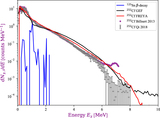MeV Gamma Rays from Fission: A Distinct Signature of Actinide Production in Neutron Star Mergers
Abstract
Neutron star mergers (NSMs) are the first verified sites of rapid neutron capture (r-process) nucleosynthesis, and could emit gamma rays from the radioactive isotopes synthesized in the neutron-rich ejecta. These MeV gamma rays may provide a unique and direct probe of the NSM environment as well as insight into the nature of the r process, just as observed gammas from the 56Ni radioactive decay chain provide a window into supernova nucleosynthesis. In this work, we include the photons from fission processes for the first time in estimates of the MeV gamma-ray signal expected from an NSM event. We consider NSM ejecta compositions with a range of neutron richness and find a dramatic difference in the predicted signal depending on whether or not fissioning nuclei are produced. The difference is most striking at photon energies above ∼3.5 MeV and at a relatively late time, several days after the merger event, when the ejecta is optically thin. We estimate that a Galactic NSM could be detectable by a next generation gamma-ray detector such as AMEGO in the MeV range, up to ∼104 days after the merger, if fissioning nuclei are robustly produced in the event.
- Publication:
-
The Astrophysical Journal
- Pub Date:
- November 2020
- DOI:
- 10.3847/2041-8213/abbe18
- arXiv:
- arXiv:2008.03335
- Bibcode:
- 2020ApJ...903L...3W
- Keywords:
-
- R-process;
- Nucleosynthesis;
- Compact binary stars;
- Gamma-rays;
- Gamma-ray transient sources;
- Supernovae;
- 1324;
- 1131;
- 283;
- 637;
- 1853;
- 1668;
- Astrophysics - High Energy Astrophysical Phenomena;
- Nuclear Theory
- E-Print:
- 9 pages, 5 figures, v2 matches version to appear in ApJL
